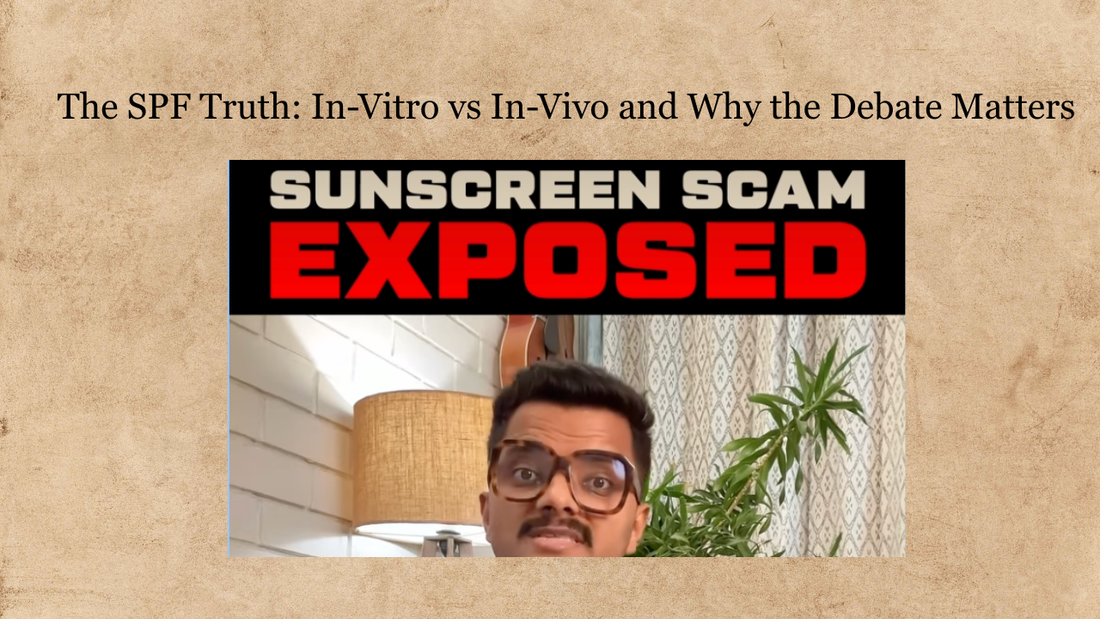Sunscreen Truth: In-Vitro vs In-Vivo Testing — What Really Matters for SPF Accuracy
In the past few weeks, conversations around sunscreen testing methods have created quite a stir online. Many people are confused between in-vitro and in-vivo SPF tests — and influencers are debating which one is “real.”
As a skincare formulator and founder of Pure Bubbles Skincare, I’d like to share a balanced perspective grounded in both science and experience.
Understanding In-Vitro vs In-Vivo SPF Testing
In-Vitro Testing (ISO 24443):
This is a non-human test method performed in the lab, under controlled conditions. It studies how UV filters behave when spread on artificial substrates that mimic skin. These tests are recognized under the COLIPA standard, which is accepted globally and used to determine UVA protection factors and SPF ratings before human trials.
In-Vivo Testing:
This is the gold standard, conducted directly on human skin to evaluate how the sunscreen performs under real-world conditions. However, in-vivo testing is expensive, time-consuming, and often restricted in countries where animal or human testing regulations are strict.
Both methods are credible. In-vitro testing gives reliable insights into UV filter performance, photo-stability, and SPF consistency, while in-vivo testing confirms final results on skin.
Why This Debate Matters for Indian Sunscreens
In India, sunscreen standards and grading systems are still evolving. Brands that voluntarily conduct ISO 24443-based testing at government-accredited labs are actually going above what’s legally required.
So when a founder invests lakhs of rupees into independent lab testing, it isn’t for marketing — it’s for transparency and education.
As someone who formulates and personally studies sunscreen chemistry, I deeply respect such efforts.
The Hard Truth About High-SPF, Lightweight Sunscreens
At Pure Bubbles, we once worked for almost two years on a potential SPF 60 sunscreen.
Here’s what I learned first-hand:
High SPF = heavier film.
No matter how advanced the filters are — whether old-generation or new-generation UV filters — they are oil-miscible molecules. As SPF levels rise, the concentration of these filters increases, which makes the texture thicker and creamier, not airy or gel-like.
That’s why when a sunscreen claims to be ultra-lightweight, invisible, matte, and SPF 60+, I always say — be curious. The math of formulation chemistry doesn’t change: true protection often feels substantial.
What Real Protection Feels Like
Personally, I don’t mind if a sunscreen leaves a slight white cast or feels a bit goopy — because that’s what often ensures genuine UV protection.
Those slightly thicker, old-school textures are the ones that truly protect sensitive skin, reduce hyperpigmentation, and prevent photo-aging.
Sunscreen isn’t makeup; it’s skin medicine.
The Way Forward for Skincare in India
This debate shouldn’t divide the skincare community. Instead, it should spark better consumer awareness, clearer SPF labeling, and standardized testing regulations in India.
We need more founders, chemists, and educators to share their learnings — not just influencers and viral trends.
At Pure Bubbles, our goal has always been simple: to help you make informed, mindful skincare choices that respect both science and skin integrity.
Let’s keep this discussion about education, not accusation. 🌞

